 |
 |
|
 |
 |
The 85th in Germany - Official Unit History
The Rhineland Operation
 The bridge site at Worms as it appears today. The towers used by snipers still exist
The bridge site at Worms as it appears today. The towers used by snipers still exist
On the 25th of March 1945 at 1400 hours Lt. Col. Perdue attended the briefing at the 3rd division headquarters.
(The Battalion was ordered to operate in support of the 3rd Division.) The briefing was on “The Rhineland Operation.”
At 1700 hours 25 March 1945 the operation section of the Battalion departed from
Eisenberg, Germany and proceeded to the city of Worms, Germany to establish advance CP. At 1900 hours the CP was established in a house fifty feet from the approach to the bridge site.
At 0200 hours 26 March
1945 the Allied artillery started a barrage across the Rhine River. At 0215 hours about five to six tanks with 105mm gun mounted moved to the river bank and fired across the river to eliminate snipers located in the tower on the far shore. This firing continued
until 0230 hours. At this time the barrage lifted and the first assault waves started to cross the river. Intermittent shelling continued all through the night to support additional assault crossings and troops on the far shore.
1st Lt. J. M. Isenberg and eight storm boat operators assigned to H&S Company this Battalion were attached to Company B 2833rd Engineer Combat Battalion for the “Rhineland Operation.”
The
mission - To land on the far shore of the Rhine the first wave of two battalions of the assault river crossing teams and to guide passengers from the final assembly areas to embarkation points. After discharging passengers on the far shore, operators were
to return boats to near shore and beach them or shuttle additional waves as directed.
The accomplishment - At 0930 hours 25 March 1945, Lt. Isenberg’s group moved from the Horcheim, Germany to the final
assembly area located south of Worms, Germany, 300 yards from the Rhine river with 22 storm boats which they were to operate on the right flank of the RCT. At 2300 hours, boats and motors were assembled and necessary preparation were made before moving to
the river bank. By 2330 hours, four boats had been placed at the bank. At that time enemy shelling started. The men were sent to pick up the fifth boat and place it at the bank. However, because of heavy enemy artillary fire, for about 30 minutes the men could
not operate. Still before the Allied artillery barrage began at 0200 hours 26 March 1945, Lt. Isenberg and his section managed to get 21 of the 22 storm boats to the bank. At 0210 hours the Infantry moved in and assembled at their respective boats (7 Infantry
men plus 2 Engineer operators per boat). All during this period the sectiion was under small arms and machine gun fire from the right flank. At 0225 hours the boats were placed into the water.
At 0230 hours
the first wave of boats with Infantry men crossed the river to establish a bridgehead. At the same time the two right flank boats operated by Pfc. C. R. Beechey and Pvt. G. V. Dockstader, Pfc. F. Aldape and Pvt. C. E. Adams with 1 Infantry officer and 16 Infantry
men proceeded up a creek that empties into the Rhine river on the far shore. The mission was to take the officer and men to the town of Lampertheim, Germany. Upon entering the creek the boats moved in about 500 yards and found an enemy barrier. This forced
the operators to discharge their passengers before reaching the town. The operators then returned to the near shore. The section continued to shuttle troops across the river until 0320 hours. At this time the section was withdrawn to an area approximately
300 yards from the river bank for safety precautions. At 0500 hours orders wre received to move the boats downstream and shuttle a reserve infantry regiment across the river. Sgt. C. Opaska and eight storm boat operators assigned to H&S Company this Battalion
were attached to Company C 2833rd Engineer Combat Battalion for the “Rhineland Operation”.
The mission - To land on the far shore of the Rhine the first wave of two battalions of the assault river
crossing teams and to guide passengers from the final assembly areas to embarkation points. After discharging passengers on the far shore operators were to return boats to near shore and beach them or shuttle additional waves as directed.
The accomplishment - At 2000 hours 25 March 1945, Sgt. Opaska’s group left Frankenthal, Germany and moved by motor vehicle to the vicinity of the Rhine
river. The assembly areas was approximately 1000 yards from the river. All the vehicles were unloaded at this point. At 2200 hours 25 March 1945 the boats and motors were hooked onto weasels and hauled down to the river bank. This task was completed by 0030
hours 26 March 1945. The movement to the river was delayed by occasional air burst and intermittent 88 fire. At 0200 hours the Allied artillary barrage began. At 0205 hours before the Allied barrage could be of any use a terrific enemy barrage arose and caused
some causualties. At 0230 hours the first wave started across the river and shuttling continued as directed. Enemy shelling continued all through to early morning and did not cease until 0605 hours when a flight of four Thunderbolts appeared overhead. Three
casualties were sustained by this group. Pfc. Joseph J. Prusasky, 7020927, SWA, three days later died from wounds received; Pfc. John P. Anich, 12167302, SWA, and Pvt. Samuel P. Christine, 33173296, WIA.
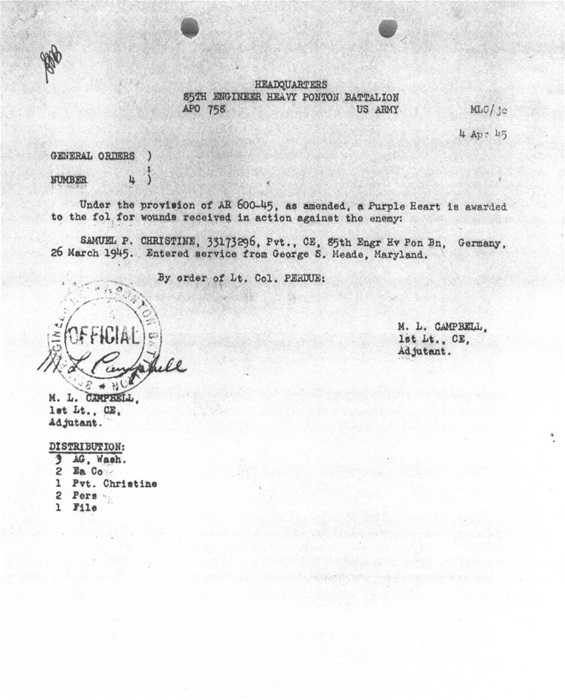 Document awarding the Purple Heart to Christine
Document awarding the Purple Heart to Christine
The Death of Joseph Prusasky
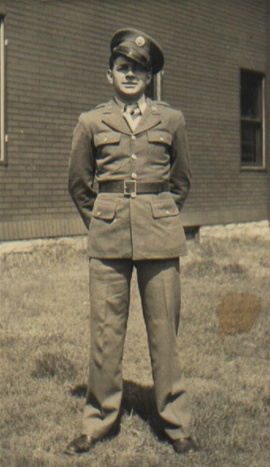 Joseph Prusasky
Joseph Prusasky
The following is the account of the death of Pfc. Joseph J. Prusasky.
On the 26th of March, 1945, at approximately 0230 hours, a section
of Headquarters and Service Company, 85th Engineer Heavy Ponton Battalion, made the assault crossing of the Rhine River in the vicinity of Frankenthat, Germany. This assault was carried out in the face of small arms and automatic weapons fire. About 0230 hours
the storm boats with crews and infantry passengers left the rear shore and proceeded to the far shore, which was held by the enemy. Upon reaching the far shore the craft were to land their troops and return to the rear shore as ordered. One of the boats failed
to return and on the next trip over one of the storm boat operators beached his craft and proceeded to look for the missing boat and operator. The missing operator was found sprawled on the beach behind a tree trunk with a serious head wound, caused presumably
by German shell fragments. He was immediately returned to the rear shore and taken to the medical aid statiion. Three days later this man died of his wounds.
The Alexander Patch Bridge at Worms
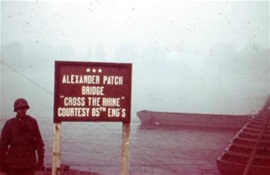
The above operation of the storm boat section is the first time in three years that the men of this section have performed their primary mission.
At
0230 hours 26 March 1945 Company A and Company B this Battalion, Company A 2833rd Engineer Combat Battalion and 3886th Quartermaster Truck Company departed from Eisenberg, Germany and proceeded to a final assembly area in Worms, Germany. The first march unit
arrived at 0500 hours. Distance traveled 20 miles. At 0500 hours Col. Marvin, Commanding Officer 540th Engineer Combat Group came into the advance CP and notified Lt. Col. Perdue, Commanding Officer 85th Engineer Heavy Ponton Battalion that the bridgehead
had been established and the Battalion could start the construction of the bridge as planned.
At 0600 hours 26 March 1945 in Worms the construction of a class 40 ponton bridge began. Company
A was responsible for the near shore, Company B the far shore and Company A 2833rd Engineer Combat Battalion for building rafts. At 1000 hours the near and far shore abutments and trestles were completed. The hinge span rafts on both shores were connected
and four additional rafts were connected to the near shore. At 1030 hours reinforcing of bridge (100% pontons) started from both shores. At the same time the placing of skin decking (2” planking) started on the near shore. At 1100 hours the Battalion
had completed 540 feet of bridge. At 1340 hours the final connection was made and at 1350 hours the last chess was laid in place. At 1505 hours the last reinforced ponton was floated into place, by 1511 hours the decking was completed. At 1512 hours the bridge
was open to traffic. The completed bridge measured from abutment to abutment was 1047 feet. The equipment in the completed bridge consisted of 131 pontons, and two trestles on both the far and near shore. The total construction time was nine hours and twelve
minutes. The bridge was named “*** ALEXANDER PATCH”. A vehicle count was taken and 3040 vehicles crossed during the first 24 hour period going east from Worms, Germany.
 The completed bridge measured from abutment to abutment was 1047 feet.
The completed bridge measured from abutment to abutment was 1047 feet.
The Gar Davidson Bridge at Mannheim
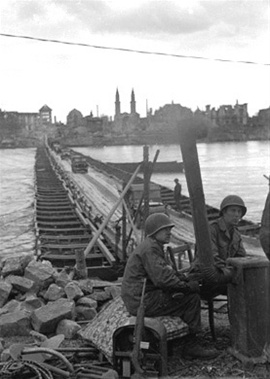 The bridge was named “***GAR DAVIDSON”.
The bridge was named “***GAR DAVIDSON”.
On 27 March 1945 in compliance with instructions from Lt. Col. Underwood, 15th Corps Engineer Forward, to the battalion thru 540th Engineer Group, the 3886th Quartermaster Truck Company and Company A of
this Battalion were sent to Toule, France, to load additional 25 ton ponton equipage and return to Worms, Germany.
On 29 March 1945 at 1500 hours, H&S Company and Battalion Headquarters departed
from Eisenberg, Germany by motor convoy and proceeded to Worms, Germany. Arrived at 1800 hours, established CP and bivouac. The advance CP was closed at 1900 hours and the operations section rejoined Battalion Headquarters.
Verbal instructions were received at Army Headquarters from the Army Engineer at 1330 hours 29 March 1945 to construct a class 40 ponton bridge in the vicinity of Mannheim. The bridge was to be completed by 1800 hours 30 March 1945.
The 1553rd Engineer Heavy Ponton Battalion was attached to the Battalion for operations. A tentative site was picked from late aerial photographs. Telephone instructions were sent to the Executive Officer and S-3 of the Battalion to make an immediate reconnaissance
of the proposed site. The reconnaissance party returned to Battalion Headquarters at 1900. Verbal instructions were given to the Company Commanders, Company A 2833rd Engineer Combat Battalion and the Commanding Officer 1553rd Engineer Heavy Ponton Battalion
at 2100 hours. The 1553rd Engineer Heavy Ponton Battalion was used only to transport and supply equipment. Eight bulldozers were dispatched to the S-3 of the Battalion at 2200 hours to proceed to the bridge site to clear the rubble from the streets and prepare
building sites. The eight bulldozers worked six hours preparing the bridge site.
At 0345 hours 30 March 1945 Company A and Company B this Battalion, Company A 2833rd Engineer Combat Battalion
and the ponton trailers of the 1553rd Engineer Heavy Ponton Battalion departed from Worms, Germany; in seven march units and proceeded south by motor convoy to the city of Ludwigshafen, Germany. The mission was to construct a class 40 ponton bridge connecting
Ludwigshafen and Mannheim, Germany. The construction of the bridge began at 0600 hours and the final connection was made at 1430 hours. At 1500 hours the bridge was completed and open to light traffic. However, due to a delay in obtaining 2” decking
the bridge was not open to heavy vehicle traffic until 1900 hours. The completed bridge measured from abutment to abutment was 893 feet in length. The equipment used consisted of 106 pontons and three trestles on both the far and near shore. The bridge was
named “***GAR DAVIDSON”. A vehicle count was taken and 3,823 vehicles traveling from Ludwigshafen to Mannheim, Germany had crossed the bridge for the first 24 hour period.
On the
31st of March 1945 Company A was given the assignment of maintaining the “GAR DAVIDSON” bridge and Company B was to maintain the “ALEXANDER PATCH” bridge.
 The completed bridge measured from abutment to abutment was 893 feet in length. A vehicle count was taken and 3,823 vehicles traveling from Ludwigshafen to Mannheim, Germany had crossed the bridge for the first 24 hour period.
The completed bridge measured from abutment to abutment was 893 feet in length. A vehicle count was taken and 3,823 vehicles traveling from Ludwigshafen to Mannheim, Germany had crossed the bridge for the first 24 hour period.
Various Assignments 4/2/45 to 4/25/45
- 4/1/45 U.S. troops encircle Germans in the Ruhr; Allied offensive in North Italy. On the 2nd of April 1945, the Battalion on verbal orders
from Engineer Section, Seventh Army, established a Floating Bridge Depot at Worms, Germany. The equipment to start this depot consisted of equipage brought from Toule, France. All excess equipment from existing Ponton Bridge Sites on the Rhine River were also
stock piled in the depot.
On the 3rd of April 1945, the Battalion received a message from Col. Eller, Engineer Section, Seventh Army which cancelled previous verbal instructions to pick up ponton
equipage from St. Jean, France.
Effective 0800 hours 4 April 1945, the Battalion was given the complete responsibility of maintaining three Heavy Ponton Bridges on the Rhine River (Ludwigshafen,
Worms, and N. of Worms). In compliance with the above message the Battalion loaded two Bailey bridges left by VI Corps at the airport north of Autobahn, east of Mannheim, Germany and transported the equipment to Engineer Depot located in Durham, Germany.
Effective 0800 hours 4 April 1945, the Battalion was relieved from attachment to 540th Engineer Combat Group and reverted to control of Headquarters Seventh Army. Effective this same date, Company A (less
2 platoons) 84th Engineer Camouflage Battalion was attached to the battalion for operations. At 1200 hours 4th April 1945, the Battalion received a message from General Davidson thru Lt. Col. Manning, CO, 540th Engineer Combat Group. The Battalion was ordered
to send an officer out to check the equipment at two captured enemy Heavy Ponton dumps, located south of Mannheim, Germany. A report as to how the equipment could be utilized was required. After a thorough check of the equipment was made, a report was submitted
to Headquarters Seventh Army. It was found that most of the equipment was serviceable. At 1700 hours 4th of April 1945 the Battalion in compliance with a message received from Col. Gaynor, Engineer Supply Section, Headquarters Seventh Army, issued four 25
ton pontons to Company B 555th Engineer Heavy Ponton Battalion for operatinal need. The equipment was issued from the Ponton Bridge Depot operated by the Battalion in Worms, Germany.
On the 5th
of April 1945, the battalion received a letter from Headquarters Seventh Army attaching the first platoon, 829th Amphibian Truck Company for operations. The Dukws of this platoon were used to maintain the river defense system protecting the Heavy Ponton Bridges.
At 1600 hours 5th of April 1945, the Battalion received a message from Engineer Section, Seventh Army, instructing the Battalion to give any technical supervision or assistance on the German Heavy Ponton Bridge being built by the 540th Engineer Combat Group.
This German bridge was to replace the existing Treadway Bridge at Ludwigshafen-Mannheim, Germany. Due to technical conditions and missing parts the German Ponton bridge could not be completed.
At
0900 hours 6 April 1945 the 1553rd Engineer Heavy Ponton Battalion relieved this organization of the maintenance of the Heavy Ponton Bridge North of Worms, Germany.
On the 6th of April 1945 in
compliance with a message received from Col. Gaynor, Engineer Supply Section, the Battalion released from the Ponton Bridge Depot six ponton loads to the 555th Engineer Heavy Ponton Battalion. In compliance with verbal instructions, later confirmed by a written
message from Engineer, Seventh Army, 6 April 1945, the Battalion sent an officer to a captured enemy Ponton dump in the vicinity of Worth, Germany to make an inventory.
On the 8th and 9th of
April 1945, Company B this organization furnished ten truck tractors with trailers to haul ponton equipage from N of Worms bridge site to Floating Bridge Depot, for the 1553rd Engineer Heavy Ponton Battalion.
At 1200 hours 10th of April 1945, the First Platoon, Company B this Battalion relieved the 1553rd Engineer Heavy Ponton Battalion of the maintenance on the class 40 Heavy Ponton Bridge at Heidelburg, Germany.
On the 10th of April 1945 Col. Eller, Engineer Section, Seventh Army, requested the Battalion to determine the amount of reserve available of Heavy Ponton Bridge. Major Prieur of the French First Army required extra equipment (approximately
28-50 pontons w/accessories) to reinforce the Heavy Ponton Bridge in the French Sector. The necessary equipment was available at the Battalion Bridge Depot. Col. Eller was informed that delivery could be made as soon as the companies were loaded. Company A
and Company B this Battalion provided twenty-five truck tractors and trailors. The vehicles were loaded with double pontons at the Ponton Bridge Depot. At 2100 hours 10 April 1945, a second message was received from Col. Eller. The Battalion was ordered not
to dispatch the ponton equipage to Major Prieur until further instructions were received from the Engineer Section, Seventh Army. The vehicles were to remain loaded and ready to move upon orders. - 4/12/45 Allies
liberate Buchenwald and Belsen concentration camps; President Roosevelt dies. Truman becomes President. On the 12th of April 1945, in compliance with a telephone conversation between this Headquarters
and Engineer Section, Seventh Army, Company B this battalion removed the Floating Mine Barrier in the vicinity of Rhein Durkheim, Germany. This equipment was salvaged and placed in the Ponton Bridge Depot for future use. -
4/16/45 Soviet troops begin their final attack on Berlin. - 4/16/45 Americans enter Nuremberg. On the 17th of April 1945 a letter received from the office
of the Engineer, Seventh Army, directed the Battalion to remove the class 40 Heavy Ponton Bridge at Worms, Germany at 0800 hours 18 April 1945. The 1175th Engineer Combat Group had been directed to assist the Battalion. The letter also stated that after the
bridge was dismantled, the battalion was to load 96 pontons with additional accessories so that a normal T/E bridge could be reinforced to Class 40. - 4/18/45 German forces in the Ruhr surrender. The Battalion started to dismantle the Heavy Ponton Bridge at 0800 hours 18 April 1945. The work was completed at 1800 hours. The vehicles were loaded and all extra equipment was stock piled in the Ponton Bridge Depot
at Worms, Gemany. Approximately 150 German PW were used to assist in this work.
On the 19th of April 1945 the 55th and 1553rd Engineer Heavy Ponton Battalion reloaded at the Ponton Bridge Depot.
On this same date an inventory was taken of the Depot.
At 0800 hours 20 April 1945, CONAD relieved this Battalion of all river patrol functions and the maintenance of the Heavy Ponton Bridges
at Ludwigshafen and Heidelberg, Germany. At this same time, Company A (less 2 platoons) 84th Engineer Camouflage Battalion and one platoon, 829th Amphibian Truck Company were relieved from attachment to the Battalion for operations. The Ponton Bridge Depot
was turned over to CONAD. Effective 1800 hours this same date, the Battalion was attached to XV Corps for operations. - 4/21/45 Soviets reach Berlin.
At
1000 hours 21 April 1945, the Battalion moved by motor convoy east of the Rhine River to Hopfingen, Germany. Arrived at 1515 and established overnight bivouac. Distance traveled 76 miles. “H&S” Company this Battalion upon arrival at Hopfingen,
Germany, was ordered to pick up 40 assault boats at the Engineer Depot and be prepared to deliver on orders from the Engineer, XV Corps.
At 0900 hours 22 April 1945, the Battalion moved by motor
convoy south to Neusitz, Germany. Arrived at 1700 hours and established overnight bivouac. Distance traveled 70 miles.
On the 23rd of April 1945, in compliance with a message received from Col.
Underwood, Engineer, XV Corps, a reconnaissance of the route via Rothenburg-Ansbach-Menkendorf-Gunzenhausen, Germany was made. A bivouac area in the vicinity of Gunzenhausen, Germany was selected. This information was reported to Col. Underwood’s office.
In compliance with the same message, the Battalion alerted the companies and supporting AAA Battery to be prepared to move at 1800 hours. At 2000 hours, movement orders were received from XV Corps. The Battalion cleared the movement through C-4 Traffic Control.
At 2200 hours the Battalion moved by motor convoy south to Gunzenhausen, Germany. Arrived at 0530 hours 24 April 1945 and established
overnight bivouac. Distance traveled 55 miles. When the convoy arrived at Gunzenhausen, Germany it wa unable to enter the bivouac area because of the 42nd Division had not moved forward. This caused a three hour delay.
At 1000 hours 24 April 1945,
in compliance with a message received from Col. Underwood, Engineer, XV Corps, H&S Company delivered 40 assault boats to the C. P., 1101st Engineer Combat Group at Weisenberg, Germany.
On the 24th of April 1945, Company A this organization was
attached to the 1109th Engineer Combat Group for the Danube River Operation. The mission of this company was to construct on orders from Commanding General, 42nd Division, a Class 40 Heavy Ponton Bridge at Site A. On the same date, Company B this organization
was attached to the 1101st Engineer Combat Group for the Danube River Operation. The mission of this company was to construct on orders from the Commanding General , 45th Division, a Class 40 Heavy Ponton Bridge at Site E. Immediately upon completion of their
respective bridges, both Company A and Company B were to revert to the control of this organization. The Battalion was ordered to supervise technical supervision over the construction of these bridges.
At 1830 hours 24 April 1945 in compliance with
orders from S-3, 1101st Engineer Combat Group, Company B this Battalion moved by motor convoy from Gunzenhausen, Germany south to Waisenburg, Germany. The company arrived at 2000 hours and established overnight bivouac. Distance traveled 22 miles.
At 0430 hours 25 April 1945 in compliance with orders from S-3, 1109th Engineer Combat Group, Company A this Battalion moved by motor convoy from Gunzenhausen, Germany south to Doekinger, Germany. The time of arrival was 0900 hours. The distance traveled
15 miles. At 1245 hours, Company B this Battalion moved by motor convoy from Weisenburg, Germany south to Monheim, Germany. The Company arrived at 1430 hours and established overnight bivouac. Distance traveled 15 miles. At 1400 hours the Battalion (less Company
A and Company B) moved by motor convoy from Gunzenhausen, Germany south to Langenaltheim, Germany. Arrived at 1700 hours and established a bivouac. Distance traveled 31 miles. At 1700 hours Company A this Battalion moved by motor convoy from Doekingen, Germany
south to Buchdorf, Germany. Arrived at 1900 hours and established overnight bivouac. Distance traveled 20 miles.
 The 85th stops for a "piss call" as it moves through Germany
The 85th stops for a "piss call" as it moves through Germany
The Danube River
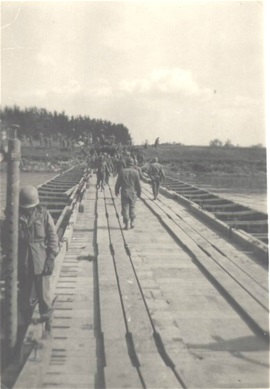 Company A started construction of 230’ Class 40 Heavy Ponton Bridge across the Danube River 26 April 1945
Company A started construction of 230’ Class 40 Heavy Ponton Bridge across the Danube River 26 April 1945
At 0530 hours 26 April 1945, Company A this Battalion, in compliance with orders received from Commanding General, 42nd Division, through Commanding Officer 1109th Engineer Combat Group, moved by motor
convoy from Buchdorf, Germany to the vicinity of Schweizerhof, Germany. The Company started construction of 230’ Class 40 Heavy Ponton Bridge across the Danube River at 0800 hours. The bridge was completed at 1530 hours and open to traffic. At 1540 hours
the bridge was closed to replace the far shore trestle which had sunk. The bridge was reopened to traffic at 1830 hours. (See photograph #1). During the afternoon of construction, the enemy shelled the area. One casualty was sustained by the company - Pfc.
Harry Maxwell - 33350421 - WIA.
At 1330 hours 26 April 1945, Company B this Battalion in compliance with orders received from Commanding General, 45th Division, thru Commanding Officer, 1101st
Engineer Combat Group, moved by motor convoy from Monheim, Germany, Germany south to Asbrunn, Germany, arrived at 1500 hours. At 1930 hours the company less a portion of Headquarters Platoon moved from Asbrunn, Germany to the vicinity of Bertoldsheim, Germany.
Upon arrival, the unit found an enemy mine field and ferry landing stage. The mines in the road were cleared and the ferry landing stage removed. At 0001 hours 27 April 1945 the Company started the construction of a 330’ Class 40 Heavy Ponton Bridge
across the Danube River. It was completed at 0945 hours and open to traffic. (Go to Official History pt 2)
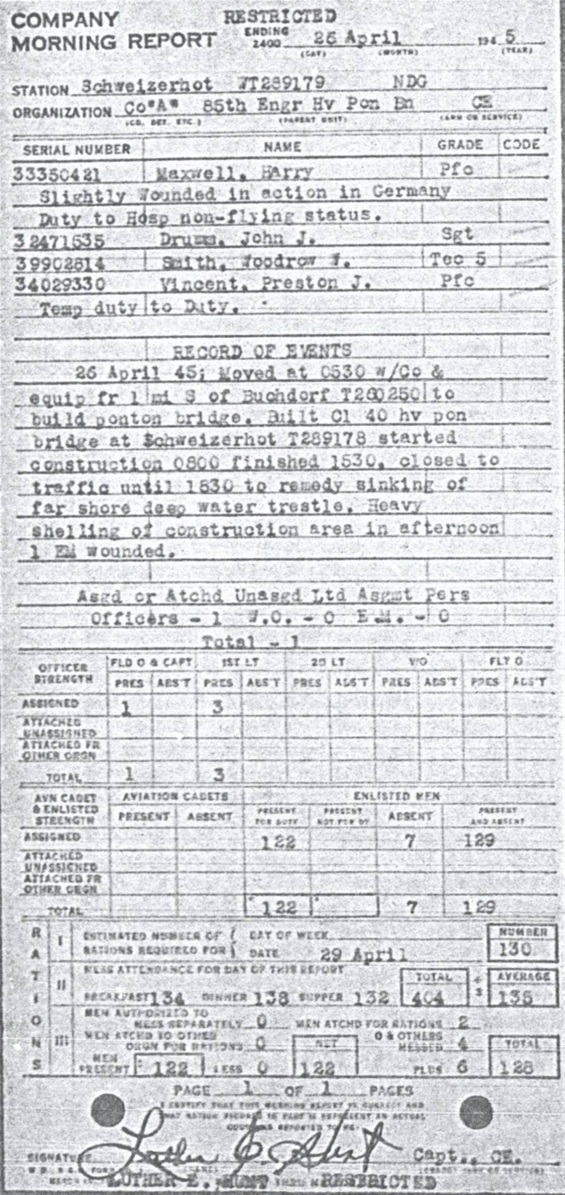 A Morning Report documents Harry Maxwell being wounded
A Morning Report documents Harry Maxwell being wounded
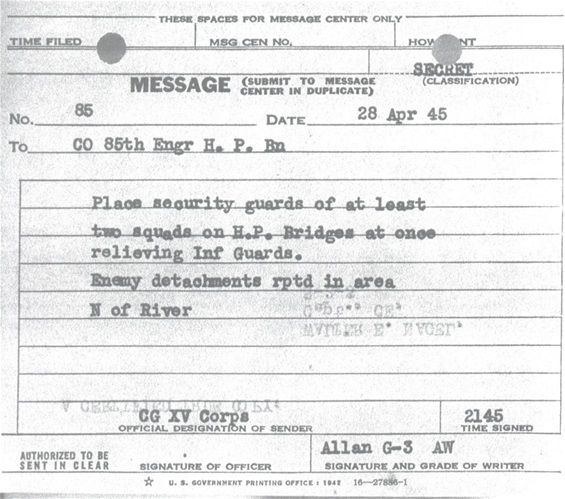 Message warning of enemy detachments in the area of the Danube bridge
Message warning of enemy detachments in the area of the Danube bridge
 Mauser rifle taken from one of two German soldiers captured by Milt O'Barr while guarding the Danube Bridge
Mauser rifle taken from one of two German soldiers captured by Milt O'Barr while guarding the Danube Bridge
|
|
 |
|
|
|